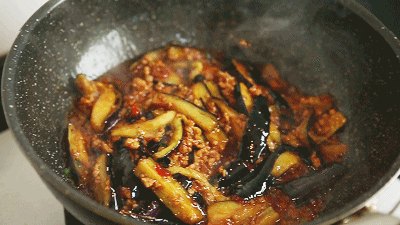Braised Eggplant with Minced Pork
1.
Wash the eggplant, cut off the head and tail, and evenly cut into 3 sections; mince the onion, ginger, and garlic.
2.
Cut each segment of eggplant into strips.
3.
Pour an appropriate amount of cooking oil into the pot, heat it to 70% hot, and add the eggplant strips. (Chopsticks measuring oil temperature: [cold oil temperature] 1-2% hot. Putting the chopsticks in the oil does not respond. At this time, it is suitable for frying nut foods, such as fried peanuts, and also suitable for frying sauces. [Low] Oil temperature] 3-4% hot. When chopsticks are placed in oil, small bubbles will appear around them. They are generally used for fried, smashed, oily and other types of dishes. [Medium oil temperature] 5-60% hot. Take a closer look at the oil There will be ripples on the surface, and the bubbles around the chopsticks will become dense, but there is no sound. It is suitable for cooking pots and cooking. [High oil temperature] 70% to 80% hot. There are a lot of bubbles around the chopsticks, and there is a crackling sound, suitable for frying or Fried meat and fish.)


4.
After frying until the surface is golden, pick it up, turn to high heat to boil the oil again, put the eggplant in the pot again, re-fry for 20 seconds, remove it, drain the oil and set aside. (Re-frying can reduce the excess oil in the eggplant)
5.
Leave the bottom oil in the pot, pour in the minced meat, stir fry until white.
6.
Add the bean paste, green onions, ginger, and garlic, and stir-fry evenly.
7.
Pour in the fried eggplant strips, then pour in light soy sauce and water starch, and stir-fry evenly. (Water starch is dried starch mixed with water to increase the viscosity of the sauce)
8.
Stir fry until the sauce is thick and ready to be served.


Tips:
1. When the eggplant is over-oiled, the moisture in it can be fried, and it will be more delicious when it is braised.
2. The braised eggplant can be peeled or not peeled, according to personal preference.
3. (1) Observe the color and impurities of the oil. If the oil is dark in color and has many impurities, it is recommended not to eat it; if the oil is not too dark in color and there are few impurities, such oil can continue to be eaten, and the remaining oil is allowed to stand before eating to remove the impurities that settle on the bottom.
(2) After frying fish, mutton and other foods, there will be a fishy smell in the leftover oil. You can put a few slices of ginger in the leftover oil and heat it for half a minute.
(3) If there is a sticky smell in the leftover oil, you can heat the leftover oil first, and then filter the food residue with a filter cloth, so that the sticky smell can be basically eliminated.
(4) Leftover oil can be used to make steamed buns or dumplings. You can put a little leftover oil on the dough, or add a little leftover oil when making fillings, which can better lock the moisture in the vegetables.
(5) When the leftover oil is used for cooking, you need to add raw oil for heating first, and then add the leftover oil, so as to avoid secondary heating of the leftover oil.
(6) The leftover oil can be used to make cold dishes.

















